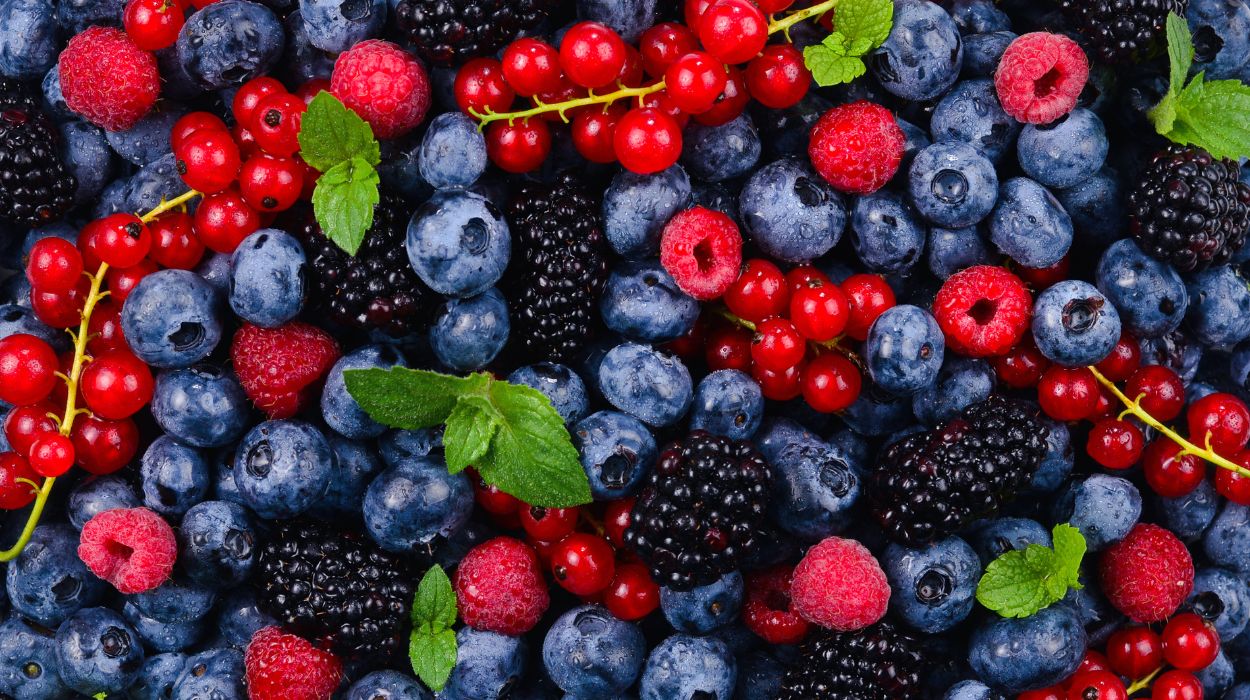 Evidence Based
Evidence Based
Evidence Based
This article is objectively based on relevant scientific literature, written by experienced medical writers, and fact-checked by a team of degreed medical experts.
Our team of registered dietitian nutritionists and licensed medical professionals seek to remain objective and unbiased while preserving the integrity of any scientific debate.
The articles contain evidence-based references from approved scientific sites. The numbers* in parentheses (*1,2,3) will take you to clickable links to our reputable sources.
7 Stunning Health Benefits Of Berries You Might Not Know 2024

Who doesn’t like to eat berries? Berries come in many different types with their golden yellow to dark pink color that awakens the appetite. They are gaining popularity as a superfood. Behind their delicious taste, berries have lots of benefits to your health.
They contain low calories, antioxidant vitamins, minerals, and polyphenols which may help reduce the effects of harmful substances, boost the immune system, and decrease the risk of chronic diseases. Read more to learn both the specific benefits of berries and the general benefits of berries.
Health Benefits Of Berries
Besides various nutrients, berries have non-nutrient compounds with antioxidant, anti-inflammatory, antimicrobial, neuroprotective, and cardioprotective effects. Some health benefits of berry consumption on overall health:
- Lower hypertension
- Lower blood lipid levels
- Help in lowering blood glucose levels if it is consumed in a healthy and balanced diet
- Low in calories, high in nutrients
- Help to increase antioxidant capacity
- Help to reduce inflammation
- Boost the immune system
Why Are Berries Good For You?
Are berries good for you? No surprise that eating berries will give you a variety of nutrients, including vitamins A, C, E, manganese, selenium, magnesium, zinc, potassium, and so on.
Blueberries

Do you like eating a handful of wild blueberries or enjoying your blueberry smoothie? Both are great since blueberries are rich in natural sugars (glucose and fructose) and fiber but low in calories. The U.S is the number one producer of blueberries.
The fruit is rich in selenium, manganese, zinc, and anthocyanins, which are strong antioxidants. Blueberries contain thirty-fold anthocyanins compared to red peel apples.
In a study[1], more than eight thousand participants’ anthocyanins intake was examined for 14 years. The highest amount of anthocyanin intake was found to be associated with decreased hypertension risk by 8%. According to the American Heart Association (AHA), berries may lower the heart attack risk in women.
Blueberries may help decrease LDL and triglycerides and increase HDL. Changes in these blood lipid biomarkers may lead to metabolic and cardiovascular disease. The cardiovascular benefits[2] of blueberries and anthocyanins probably come from their antioxidant and anti-inflammatory properties.
In a 2013 study, 150 hypercholesterolemia participants were given purified anthocyanin for 24 weeks. After 12 weeks, patients’ LDL (“bad”) cholesterol decreased, and HDL (“good”) cholesterol increased. At the end of 24 weeks, there was a decrease in inflammatory marker high-sensitivity C-reactive protein ( hs-CRP), a commonly used biomarker to assess inflammation levels in the body.
Another benefit of blueberries is that they are in the category of low glycemic index[3] foods. Food’s glycemic index is used to determine food’s capacity to increase blood sugar levels. If a food’s glycemic index is high, it quickly increases blood sugar levels resulting in increased insulin synthesis, which then quickly lowers blood sugar levels resulting in hunger.
That’s why low glycemic index foods are recommended in weight management or in the case of metabolic diseases such as diabetes or metabolic syndrome[4].
100 grams[5] of blueberries contain
- 64 kcal
- 0.7 g protein
- 14.6 g carbohydrate
- 12 mg calcium
- 0.34 mg iron
- 6.2 mg magnesium
- 13 mg phosphorus
- 86 mg potassium
- 0.4 mg manganese
- <2 mg of sodium (low, important in those watching their salt intake)
- 8.1 mg vitamin C
Blackberries

Phenolic compounds of blackberry may have protective effects[6] on age-related neurodegenerative diseases. Environmental pollutants and biological processes result in free radical production, which causes oxidative stress to cells causing cell damage and even death. To us, it’s what we call aging.
Oxidative stress is one of the leading causes of brain aging and neurodegenerative diseases[7]. Because blackberries have a high antioxidant capacity, they may help decrease oxidative stress; thus, eating blackberries may protect brain cells.
Berries contain antioxidant compounds[8] called phenolic acids, flavonoids, and vitamin C. Antioxidant compounds’ compositions and the quality of fruits will change based on environmental conditions, ripeness stage, harvest time, and storage conditions.
Blackberries are generally consumed in frozen forms. In processed forms of blackberries, such as canned blackberries, more than 20% of antioxidant properties are lost when processing for preservation. Thus eating fresh blackberries will give you more polyphenols.
100 grams of blackberries (a little less than 1 cup) contains[9]
- 43 kcal
- 1.39 g protein
- 9.61 g carbohydrate
- 5.3 g fiber
- 21 mg vitamin C
- 29 mg calcium
- 0.63 mg iron
- 20 mg magnesium
- 22 g phosphorus
- 162 mg potassium
- 1 mg sodium
- 0.4 mcg selenium
- 25 mcg folate
- 11 mcg vitamin A
Cranberries
The benefits of cranberries as an antimicrobial[10] are gaining popularity. Cranberries are known for preventing and treating occurrences of urinary tract infections. Bacteria need to adhere to cells and tissues to cause an infection.
One of the most common urinary tract infections, caused by Escherichia coli (E.Coli), constitutes 85-95 % of cystitis (bladder infection). Urinary tract infections affect lots of women. ⅓ of women have a urinary tract infection at least once in their lifetime. 11.3 million women have a urinary tract infection in the U.S. annually. If it is left untreated, it may cause serious illnesses such as kidney failure.
The science behind cranberry juice and tablets’ effects on preventing UTIs is controversial. Cranberries contain[11] 2 substances that interfere with bacterial adherence as well as reduce the pH (increases acidity) to mitigate infection.
In a study, either 4 oz or 8 cranberry juice or a placebo were given twice a day to premenopausal women with a recent UTI episode. There was no significant reduction in UTI risk between groups given cranberry juice and the control group. However, the results of a meta-analysis[12] of 7 studies concluded that cranberry reduced UTI risk by 26%.
1 cup[13] of cranberries contain
- 46 kcal
- 0.4 g protein
- 12 g carbohydrate
- 3.6 g fiber
- 8 mg calcium
- 0.2 mg iron
- 6 mg magnesium
- 11 mg phosphorus
- 80 mg potassium
- 14 mg vitamin C
- 63 IU vitamin A
- 91 mcg lutein + zeaxanthin
- 1.3 mg vitamin E
Goji Berries
Goji berries[14] are usually grown in Asia. Some people cook dry goji berries before eating. It is commonly used in herbal tea and Chinese soups.
The benefits of goji berries come from the vitamin[15] B complex, C, and E, the eight essential amino acids, and polyphenols.
Goji berries may show beneficial effects on eye health[16], especially age-related macular degeneration (AMD). AMD is one of the causes of vision loss in older people. Goji berries may help in preventing or slowing the development of AMD.
Goji berries contain lutein and zeaxanthin, which filter harmful blue light and show antioxidant effects that protect the eyes during aging.
In a study[17], 28 grams of goji berries (about 1 ounce) were given 5 times a week to 13 healthy adults aged between 45 – 65 for 3 months. Eating goji berries increased the density of protective pigments in participants’ eyes. Keep in mind that goji berries may interact with blood thinners, blood pressure, and diabetes medications.
100 g of goji berries contain[18]
- 349 kcal
- 14.3 g protein
- 77 g carbohydrate
- 13 g fiber
- 190 mg calcium
- 6.8 mg iron
- 48.4 mg vitamin C
- 26800 IU vitamin A
Golden Berries
Golden berries are rich in carotenoids. Our bodies can convert carotenoids to vitamin A, an important vitamin for eye health, cell growth, and the immune system. Golden berries contain a plant sterol called phytosterols which help lower bad cholesterol (LDL) in your blood. Golden berries may have promising benefits on liver health.
In an animal study[19], a group of animals with liver and kidney damage were treated with golden berry extraction. The fruit extraction showed protection against damage to the liver and kidney in rats; however, more research is needed to document the health benefits of golden berries for humans.
30 g of golden berries contain[20]
- 300 kcal
- 1 g protein
- 23 g carbohydrate
- 3 g fiber
- 0.7 mg iron
- 351 mg potassium
- 6 mg vitamin C
- 420 IU vitamin A
Strawberries
Strawberries are one of the favorite summer fruits with their naturally sweet taste. Strawberries are high in vitamin C. When you eat 100 g of strawberry, you get about 60 mg of vitamin C which meets more than 60% of the daily requirement of the vitamin. It is one of the fruits that contain a good amount of folate.
100 grams (about 8-10 ) of strawberry contains[21]
- 32 kcal
- 2 g fiber
- 5 g of total fruit sugar (fructose, glucose, and sucrose), which is ⅓ of what a banana[22] contains
- 60 mg of vitamin C
- 24 mcg folate
- 24 mg phosphorus
- 13 mg magnesium
- 1 mg sodium
One thing you may want to consider about strawberries is that they are on the Environmental Working Group’s (EWG) list of fruits and vegetables that contain the highest levels of pesticide residue.
Raspberries
Raspberries contain a good amount of fiber, among other berries. Eating enough fiber helps your digestive system work better. Regular bowel movements are also important for the general health of the digestive tract. Women should eat 21 to 25 grams of fiber, and men should eat 30 to 38 grams of fiber daily.
Fiber is also helpful for regulating blood sugar levels. Raspberries are low in sugar compared to most fruits. Thus, raspberries could be a great choice for a diabetic person. However, if you eat frozen berries, read the labels to ensure not to buy packages containing added sugar.
Cognitive decline is one of the signs of neurodegenerative diseases[23] such as Alzheimer’s and Parkinson’s disease. Cognitive decline may be one of the results of brain aging. Antioxidants found in raspberries may help clear toxic proteins accumulating in the brain cells.
Antioxidants in raspberries may help reduce inflammation. Arthritis is one of the inflammatory diseases that cause pain in joints. The raspberry extract has been shown to reduce swelling and joint damage in rats with arthritis[24].
To get most of the antioxidants of raspberries, choose to eat fresh berries. Raspberries are harvested in summer and fall, so they should be fresh at those times.
100 grams[25] of raspberries contain
- 52 kcal
- 11.9 g carbohydrate
- 5 g sugar
- 6.5 g fiber
- 25 mg calcium
- 22 mg magnesium
- 29 mg phosphorus
- 151 mg potassium
- 26 mg vitamin C
- 21 mcg folate
Which Berry Is The Most Nutritious?
There are no “healthiest” foods. However, blackberry and strawberry meet 10 % of the daily value of 17 nutrients, including potassium, fiber, protein, calcium, iron, folate, zinc, niacin, thiamine, vitamins B6, B12, C, D, E, and K per 100 kcal, according to the Centers for Disease Control and Prevention (CDC)[26].
However, diversity is an essential component of a healthy diet. It is best to eat various fruits to get diverse vitamins, minerals, and antioxidant compounds.
Final Thought
Now you know the benefits of a berries smoothie. Adapting an anti-inflammatory lifestyle may prevent diseases since chronic diseases often result from chronic inflammation. Avoiding unhealthy food choices while eating fresh fruit may be a good way for chronic disease management or even prevention.
Like other fruits, berries contain fiber, vitamins, minerals, and antioxidant compounds. Berries have lots of benefits to your health. Still, you should eat different types of fruits in a day because different colors of fruits contain different antioxidant nutrients. Don’t forget to eat 5 portions of fruit and vegetables to maintain a healthy and balanced daily diet.
+ 26 sources
Health Canal avoids using tertiary references. We have strict sourcing guidelines and rely on peer-reviewed studies, academic researches from medical associations and institutions. To ensure the accuracy of articles in Health Canal, you can read more about the editorial process here
- Cassidy, A., O’Reilly, É.J., Kay, C., Sampson, L., Franz, M., Forman, J., Curhan, G. and Rimm, E.B. (2010). Habitual intake of flavonoid subclasses and incident hypertension in adults. The American Journal of Clinical Nutrition, [online] 93(2), pp.338–347. doi:10.3945/ajcn.110.006783.
- Xu, Z., Xie, J., Zhang, H., Pang, J., Li, Q., Wang, X., Xu, H., Sun, X., Zhao, H., Yang, Y. and Ling, W. (2020). Anthocyanin supplementation at different doses improves cholesterol efflux capacity in subjects with dyslipidemia—a randomized controlled trial. European Journal of Clinical Nutrition, [online] 75(2), pp.345–354. doi:10.1038/s41430-020-0609-4.
- NHS Choices (2022). What is the glycaemic index (GI)? [online] Available at: https://www.nhs.uk/common-health-questions/food-and-diet/what-is-the-glycaemic-index-gi/
- Nilsson, P.M., Tuomilehto, J. and Rydén, L. (2019). The metabolic syndrome – What is it and how should it be managed? European Journal of Preventive Cardiology, [online] 26(2_suppl), pp.33–46. doi:10.1177/2047487319886404.
- Usda.gov. (2022). FoodData Central. [online] Available at: https://fdc.nal.usda.gov/fdc-app.html#/food-details/2263889/nutrients
- Kaume, L., Howard, L.R. and Devareddy, L. (2011). The Blackberry Fruit: A Review on Its Composition and Chemistry, Metabolism and Bioavailability, and Health Benefits. Journal of Agricultural and Food Chemistry, [online] 60(23), pp.5716–5727. doi:10.1021/jf203318p.
- Essa, M., Subash, S., Al-Adawi, S., Memon, M., Manivasagam, T. and Akbar, M. (2014). Neuroprotective effects of berry fruits on neurodegenerative diseases. Neural Regeneration Research, [online] 9(16), p.1557. doi:10.4103/1673-5374.139483.
- Skrovankova, S., Sumczynski, D., Mlcek, J., Jurikova, T. and Sochor, J. (2015). Bioactive Compounds and Antioxidant Activity in Different Types of Berries. International Journal of Molecular Sciences, [online] 16(10), pp.24673–24706. doi:10.3390/ijms161024673.
- Usda.gov. (2022). FoodData Central. [online] Available at: https://fdc.nal.usda.gov/fdc-app.html#/food-details/173946/nutrients
- Kranz, S., Guellmar, A., Olschowsky, P., Tonndorf-Martini, S., Heyder, M., Pfister, W., Reise, M. and Sigusch, B. (2020). Antimicrobial Effect of Natural Berry Juices on Common Oral Pathogenic Bacteria. Antibiotics, [online] 9(9), p.533. doi:10.3390/antibiotics9090533.
- Raz, R., Chazan, B. and Dan, M. (2004). Cranberry Juice and Urinary Tract Infection. Clinical Infectious Diseases, [online] 38(10), pp.1413–1419. doi:10.1086/386328.
- Fu, Z., Liska, D., Talan, D. and Chung, M. (2017). Cranberry Reduces the Risk of Urinary Tract Infection Recurrence in Otherwise Healthy Women: A Systematic Review and Meta-Analysis. The Journal of Nutrition, [online] 147(12), pp.2282–2288. doi:10.3945/jn.117.254961.
- Usda.gov. (2022). FoodData Central. [online] Available at: https://fdc.nal.usda.gov/fdc-app.html#/food-details/171722/nutrients
- Ma, Z.F., Zhang, H., Teh, S.S., Wang, C.W., Zhang, Y., Hayford, F., Wang, L., Ma, T., Dong, Z., Zhang, Y. and Zhu, Y. (2019). Goji Berries as a Potential Natural Antioxidant Medicine: An Insight into Their Molecular Mechanisms of Action. Oxidative Medicine and Cellular Longevity, [online] 2019, pp.1–9. doi:10.1155/2019/2437397.
- Jeszka-Skowron, M., Zgoła-Grześkowiak, A., Stanisz, E. and Waśkiewicz, A. (2017). Potential health benefits and quality of dried fruits: Goji fruits, cranberries and raisins. Food Chemistry, [online] 221, pp.228–236. doi:10.1016/j.foodchem.2016.10.049.
- Skenderidis, P., Leontopoulos, S. and Lampakis, D. (2022). Goji Berry: Health Promoting Properties. Nutraceuticals, [online] 2(1), pp.32–48. doi:10.3390/nutraceuticals2010003.
- null (2022). Dried goji berries may provide protection against age-related macular degeneration. [online] news. Available at: https://health.ucdavis.edu/news/headlines/dried-goji-berries-may-provide-protection-against-age-related-macular-degeneration/2022/01.
- Usda.gov. (2022). FoodData Central. [online] Available at: https://fdc.nal.usda.gov/fdc-app.html#/food-details/173032/nutrients
- El-Gengaihi, S.E., Hamed, M.A., Khalaf-Allah, A.E.-R.M. and Mohammed, M.A. (2013). Golden Berry Juice Attenuates the Severity of Hepatorenal Injury. Journal of Dietary Supplements, [online] 10(4), pp.357–369. doi:10.3109/19390211.2013.830675.
- Usda.gov. (2022). FoodData Central. [online] Available at: https://fdc.nal.usda.gov/fdc-app.html#/food-details/1064107/nutrients
- Usda.gov. (2022). FoodData Central. [online] Available at: https://fdc.nal.usda.gov/fdc-app.html#/food-details/167762/nutrients
- Usda.gov. (2022). FoodData Central. [online] Available at: https://fdc.nal.usda.gov/fdc-app.html#/food-details/1105073/nutrients
- Corey-Bloom, J. (2002). The ABC of Alzheimer’s Disease: Cognitive Changes and Their Management in Alzheimer’s Disease and Related Dementias. International Psychogeriatrics, [online] 14(S1), pp.51–75. doi:10.1017/s1041610203008664.
- Figueira, M.E., Câmara, M.B., Direito, R., Rocha, J., Serra, A.T., Duarte, C.M.M., Fernandes, A., Freitas, M., Fernandes, E., Marques, M.C., Bronze, M.R. and Sepodes, B. (2014). Chemical characterization of a red raspberry fruit extract and evaluation of its pharmacological effects in experimental models of acute inflammation and collagen-induced arthritis. Food Funct., [online] 5(12), pp.3241–3251. doi:10.1039/c4fo00376d.
- Usda.gov. (2022). FoodData Central. [online] Available at: https://fdc.nal.usda.gov/fdc-app.html#/food-details/167755/nutrients
- Di Noia, J. (2014). Defining Powerhouse Fruits and Vegetables: A Nutrient Density Approach. Preventing Chronic Disease, [online] 11. doi:10.5888/pcd11.130390.



